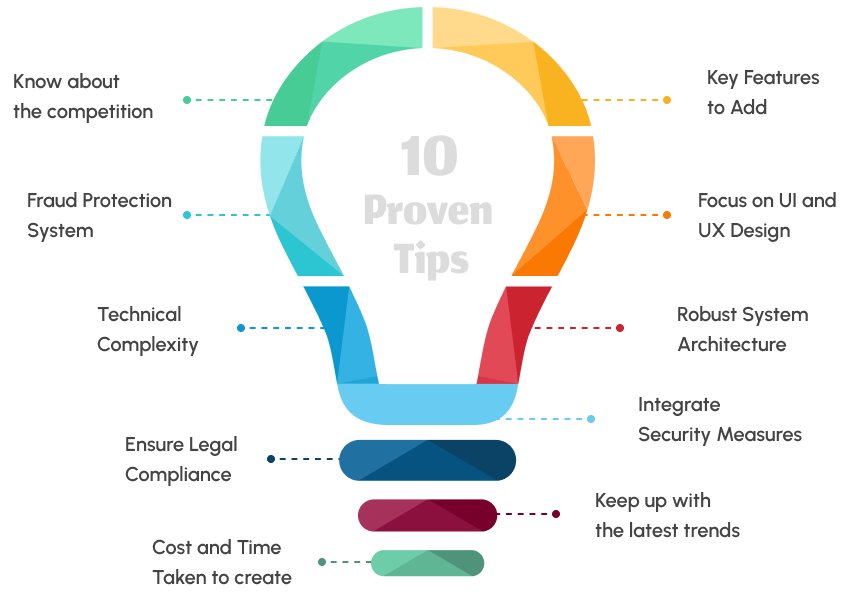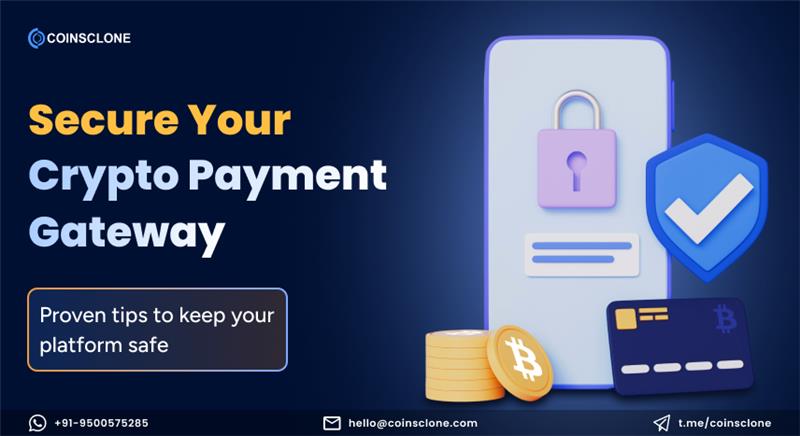As we enter 2026, the cryptocurrency landscape is simply overpowering at an unprecedented rate. With new security threats emerging, high-profile hacks making headlines, and stricter regulatory compliance requirements taking center stage, safeguarding your crypto assets has never been more critical.
Imagine this: you’ve poured time and resources into building a seamless online store with a fully integrated crypto payment gateway. Everything seems perfect, transactions flow smoothly, and your customers are delighted. But beneath the surface, cybercriminals are constantly searching for vulnerabilities to exploit.
You’ve built your crypto payment gateway, now, how do you protect it?
In this article, we’ll explore proven strategies to secure your crypto payment gateway in 2026 and keep your platform safe from evolving threats.
See How Our Proven System Can Secure Your Crypto Payment Gateway
Crypto Payment Gateway Development — done right.
-
Advanced Security Stack : Multi-sig wallets, 2FA, SSL, and DDoS protection by default.
-
Compliance-Ready : Built-in KYC/AML modules to meet global regulations.
-
Fraud Prevention : Real-time monitoring and risk scoring to block suspicious transactions.
-
Data Protection : End-to-end encryption for all payment and user data.
Get a free security audit checklist to evaluate your payment system’s safety.
Book a Free Demo to learn how our Crypto Payment Gateway Development Solution helps you launch faster — and safer.
Why Security Is Non-Negotiable for Crypto Payment Gateways in 2026
The crypto space continues to expand rapidly, but so do the threats lurking behind it. As digital payments become more mainstream, hackers are finding new ways to exploit vulnerabilities in crypto payment gateways. From phishing scams to DeFi exploits, the sophistication of attacks has grown significantly, leaving unprepared businesses at serious risk.
According to industry reports, over $1.5 billion worth of cryptocurrencies were stolen in 2024 alone through various hacks and exploits. A major portion of these incidents stemmed from weak security configurations, compromised APIs, and wallet key leaks. Additionally, phishing attacks targeting both users and merchants have surged, making security awareness as critical as technical safeguards.
In an ecosystem built on transparency and trust, even a single breach can damage your platform’s reputation and user confidence. That’s why ensuring end-to-end protection isn’t just a technical necessity; it’s a business imperative.
So, what can businesses do to stay ahead?
Common Security Risks in Crypto Payment Gateways
While crypto payment gateways enable fast and borderless transactions, they also attract a wide range of cyber threats. Understanding the most common risks is the first step toward building a secure environment for your users and merchants.
Here are some of the key vulnerabilities that businesses should watch out for:
- Transaction Interception: Attackers may attempt to intercept data during transfer, manipulating transaction details or rerouting funds.
- API Vulnerabilities: Weak or unprotected APIs can give hackers unauthorized access to sensitive transaction data and user information.
- Wallet Key Exposure: Poor key management practices can lead to the loss or theft of private keys, allowing attackers to gain complete control over user funds.
- Smart Contract Bugs: Coding errors or unverified contracts can open backdoors for exploits in decentralized payment systems
- Insider Attacks: Employees or developers with privileged access might misuse their authority for personal gain or sabotage.
Key Threats and Preventive Measures
|
Transaction Interception |
Use SSL/TLS encryption and blockchain-based transaction validation. |
| API Vulnerabilities | Regularly test APIs, use authentication tokens, and restrict access with role-based permissions. |
| Wallet Key Exposure | Store private keys in hardware wallets or secure multi-signature wallets. |
| Smart Contract Bugs | Conduct third-party smart contract audits and continuous code reviews. |
| Insider Attacks | Implement role-based access control (RBAC) and monitor admin activity logs. |
By addressing these vulnerabilities early, businesses can prevent catastrophic breaches and ensure their payment ecosystem remains resilient. So, how can you turn these insights into actionable protection? Let’s break it down.
Top 10 Tips to Secure Your Crypto Payment Gateway
Building a crypto payment gateway is one thing; keeping it secure in today’s threat landscape is another. As the value and volume of crypto transactions continue to grow, adopting a proactive and layered security approach becomes essential. Here are the top 10 proven strategies to safeguard your crypto payment gateway against evolving threats in 2026.
1. Conduct Regular Security Audits
Security isn’t static. Conducting regular audits helps you identify potential vulnerabilities before attackers do. Partner with professional cybersecurity firms or blockchain security experts to perform penetration testing, smart contract reviews, and infrastructure assessments. Consistent audits ensure that your platform remains resilient against both internal flaws and external attacks.
2. Implement Multi-Layer Encryption
Encryption is your first line of defense against data theft. Use multi-layer encryption protocols (like AES-256) to secure transaction data, private keys, and user credentials. Implement end-to-end encryption across every communication layer so that even if data is intercepted, it remains unreadable to unauthorized parties.
3. Use Multi-Signature and Two-Factor Authentication
Strengthen user and admin access with multi-signature (multi-sig) wallets and two-factor authentication (2FA). Multi-sig ensures that multiple private keys are required to authorize a transaction, reducing the risk of a single point of failure. 2FA adds a verification layer, making unauthorized access significantly harder.
4. Enable Real-Time Fraud Monitoring
Integrate real-time monitoring tools powered by AI and blockchain analytics to detect suspicious activity instantly. Look for abnormal transaction patterns, sudden fund movements, or repetitive failed login attempts. Early detection enables swift responses, minimizing financial loss and reputational damage.
5. Enforce KYC/AML Compliance
In an era of increasing regulation, Know Your Customer (KYC) and Anti-Money Laundering (AML) compliance are non-negotiable. Verifying user identities helps prevent fraudulent accounts and illegal transactions. Compliance not only strengthens your platform’s legitimacy but also builds user trust and satisfies global regulatory requirements.

6. Harden Your API and Server Security
APIs are the backbone of crypto payment systems and a prime target for hackers. Implement rate limiting, authentication tokens, IP whitelisting, and HTTPS protocols to secure your APIs. Keep servers updated with the latest patches and use firewalls and intrusion detection systems (IDS) to block malicious traffic.
7. Create Secure Backup and Recovery Systems
Even with strong security, breaches or failures can still occur. Having a robust backup and disaster recovery plan ensures your operations remain uninterrupted. Regularly back up transaction data and wallet information to secure, off-site locations. In the event of a breach, you can restore systems quickly without data loss.
8. Educate Merchants and End-Users on Security Practices
Technology alone can’t guarantee safety awareness plays a huge role. Educate your merchants and users about phishing scams, password hygiene, and wallet protection techniques. Provide regular security updates and tutorials to keep your user base informed and vigilant.
9. Keep Up with Security Innovations and Standards
The crypto industry evolves rapidly, and so do attack vectors. Stay ahead by following the latest blockchain security frameworks, DeFi audit standards, and global compliance guidelines. Adopting updated technologies like zero-knowledge proofs or hardware security modules (HSMs) can significantly strengthen your platform’s defenses.
10. Partner with Experts for Continuous Security Assessment
Security isn’t a one-time process; it’s a continuous process. Collaborate with a crypto payment gateway development company or compliance specialists for ongoing assessments and incident response planning. These experts can help you identify blind spots, manage evolving risks, and maintain a consistent security posture throughout the year.
By implementing these strategies, your crypto payment gateway can operate with confidence, providing both users and merchants a safe, transparent, and reliable transaction experience. Next, let’s look at the key regulatory and compliance considerations every crypto payment platform should follow.
Security becomes truly effective when it’s built into the foundation of your payment system, not added later. If you’re planning to develop one,
Explore our step-by-step guide on How to Create a Crypto Payment Gateway to understand the complete process from architecture and integration to robust security implementation.
Regulatory and Compliance Considerations to Secure Your Crypto Payment Gateway
As crypto adoption grows, so does the spotlight on regulatory compliance. Governments and financial authorities across the globe are tightening their rules to combat money laundering, fraud, and illicit financial activities. For crypto payment gateways, staying compliant isn’t just about avoiding penalties; it’s about ensuring credibility and long-term sustainability.
GDPR (General Data Protection Regulation)
If your platform serves users in the EU, GDPR compliance is mandatory. It requires you to safeguard user data, obtain clear consent before collection, and provide transparency about how data is stored or processed. Any non-compliance could result in hefty fines and loss of customer trust.
KYC (Know Your Customer) and AML (Anti-Money Laundering)
These regulations form the backbone of crypto security and trust. Enforcing KYC/AML policies helps identify and verify users, track suspicious transactions, and prevent illicit fund transfers. Many leading gateways integrate automated verification systems to streamline compliance without affecting user experience.
FATF (Financial Action Task Force) Guidelines
The FATF continues to refine its Travel Rule, requiring virtual asset service providers (VASPs) to share sender and receiver information during transactions. Adhering to these standards enhances global interoperability and reinforces trust between platforms.
Local and Regional Regulations
Crypto compliance also varies by region. For example, the U.S. FinCEN enforces strict reporting requirements, while India’s FIU-IND mandates registration and detailed transaction reporting. Staying up to date with your jurisdiction’s evolving laws helps you avoid legal complications and ensures seamless operations.
By aligning with these regulatory frameworks, businesses not only protect themselves from legal risk but also enhance their platform’s integrity, a key factor in building user confidence. With both security and compliance working hand in hand, the foundation for a trustworthy crypto payment ecosystem becomes stronger than ever.
Once you’ve ensured your crypto payment gateway meets the highest security and compliance standards, the next step is understanding the financial side of development. Explore our detailed breakdown on Cost to Create a Crypto Payment Gateway – covering key cost factors, development phases, and ways to optimize your investment.
Final Thoughts
Security isn’t a one-time setup; it’s an ongoing process. In 2026 and beyond, protecting your crypto payment gateway means constant vigilance, regular audits, and a proactive security-first mindset.
The crypto industry thrives on innovation, but innovation without security can lead to disaster. By combining robust technical safeguards with strong regulatory compliance, your payment gateway can stand firm against the ever-evolving landscape of cyber threats.
In short, a secure crypto payment gateway is more than just a feature; it’s your brand’s promise of trust and reliability in the decentralized financial world.
See How Our Proven System Can Secure Your Crypto Payment Gateway
Crypto Payment Gateway Development — done right.
-
Advanced Security Stack : Multi-sig wallets, 2FA, SSL, and DDoS protection by default.
-
Compliance-Ready : Built-in KYC/AML modules to meet global regulations.
-
Fraud Prevention : Real-time monitoring and risk scoring to block suspicious transactions.
-
Data Protection : End-to-end encryption for all payment and user data.
Get a free security audit checklist to evaluate your payment system’s safety.
Book a Free Demo to learn how our Crypto Payment Gateway Development Solution helps you launch faster — and safer.
